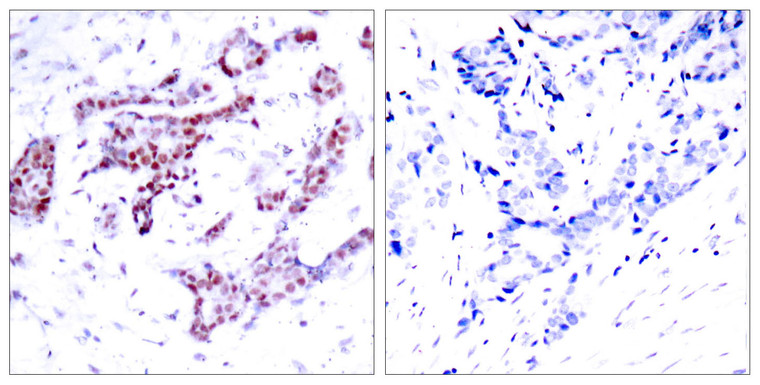-
Western blot analysis of lysates from COS7 cells, using STAT1 (Phospho-Tyr701) Antibody. The lane on the right is blocked with the phospho peptide.
-
Western blot analysis of lysates from 1) MOUSE-BRAIN, 2) SY-SY5X, 3) COS7 cells, (Green) primary antibody was diluted at 1:1000, 4°C over night, secondary antibody (cat: (NA) was diluted at 1:10000, 37°C 1hour. (Red) Actin Beta monoclonal antibody (5B7) (cat: (STJ96930) antibody was diluted at 1:5000 as loading control, 4°C over night, secondary antibody (cat: (NA) was diluted at 1:10000, 37°C 1hour.
-
Western blot analysis of COS7 cells using Phospho-Stat1 (Y701) Polyclonal Antibody diluted at 1:1000
-
Immunohistochemistry analysis of paraffin-embedded human breast carcinoma, using STAT1 (Phospho-Tyr701) Antibody. The picture on the right is blocked with the phospho peptide.
-
Immunohistochemical analysis of paraffin-embedded Mouse-spleen tissue. 1, Stat1 (phospho Tyr701) Polyclonal Antibody was diluted at 1:200 (4°C, overnight). 2, Sodium citrate pH 6.0 was used for antibody retrieval (>98°C, 20min). 3, Secondary antibody was diluted at 1:200 (room tempeRature, 30min). Negative control was used by secondary antibody only.
-
Western blot analysis of various cells using Phospho-Stat1 (Y701) Polyclonal Antibody diluted at 1:1000
-
Immunohistochemical analysis of paraffin-embedded Rat-lung tissue. 1, Stat1 (phospho Tyr701) Polyclonal Antibody was diluted at 1:200 (4°C, overnight). 2, Sodium citrate pH 6.0 was used for antibody retrieval (>98°C, 20min). 3, Secondary antibody was diluted at 1:200 (room tempeRature, 30min). Negative control was used by secondary antibody only.
-
Immunohistochemical analysis of paraffin-embedded Mouse-liver tissue. 1, Stat1 (phospho Tyr701) Polyclonal Antibody was diluted at 1:200 (4°C, overnight). 2, Sodium citrate pH 6.0 was used for antibody retrieval (>98°C, 20min). 3, Secondary antibody was diluted at 1:200 (room tempeRature, 30min). Negative control was used by secondary antibody only.
-
Immunofluorescence analysis of mouse-spleen tissue. 1, Stat1 (phospho Tyr701) Polyclonal Antibody (red) was diluted at 1:200 (4°C, overnight). 2, Cy3 labled Secondary antibody was diluted at 1:300 (room temperature, 50min).3, Picture B: DAPI (blue) 10min. Picture A:Target. Picture B: DAPI. Picture C: merge of A+B
-
Immunofluorescence analysis of mouse-spleen tissue. 1, Stat1 (phospho Tyr701) Polyclonal Antibody (red) was diluted at 1:200 (4°C, overnight). 2, Cy3 labled Secondary antibody was diluted at 1:300 (room temperature, 50min).3, Picture B: DAPI (blue) 10min. Picture A:Target. Picture B: DAPI. Picture C: merge of A+B
-
Immunofluorescence analysis of rat-spleen tissue. 1, Stat1 (phospho Tyr701) Polyclonal Antibody (red) was diluted at 1:200 (4°C, overnight). 2, Cy3 labled Secondary antibody was diluted at 1:300 (room temperature, 50min).3, Picture B: DAPI (blue) 10min. Picture A:Target. Picture B: DAPI. Picture C: merge of A+B
-
Immunofluorescence analysis of rat-spleen tissue. 1, Stat1 (phospho Tyr701) Polyclonal Antibody (red) was diluted at 1:200 (4°C, overnight). 2, Cy3 labled Secondary antibody was diluted at 1:300 (room temperature, 50min).3, Picture B: DAPI (blue) 10min. Picture A:Target. Picture B: DAPI. Picture C: merge of A+B
-
Immunofluorescence analysis of Hela cell. 1, Stat1 (phospho Tyr701) Polyclonal Antibody (red) was diluted at 1:200 (4°C overnight). HER2 monoclonal antibody (11H9) (green) was diluted at 1:200 (4°C overnight). 2, Goat Anti Rabbit Alexa Fluor 594 Catalog: (NA was diluted at 1:1000 (room temperature, 50min). Goat Anti Mouse Alexa Fluor 488 Catalog: (NA was diluted at 1:1000 (room temperature, 50min).



















